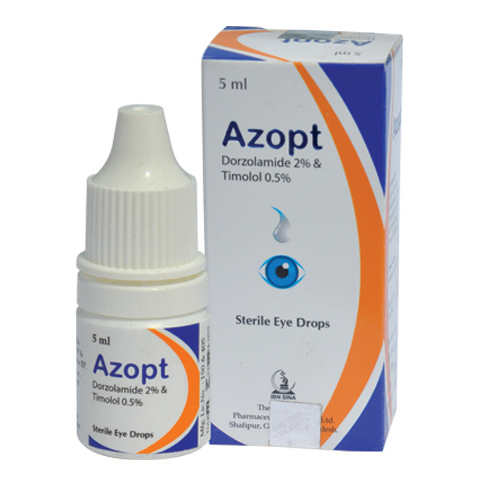Azopt Uses, Dosage, Side Effects and more
Azopt is a carbonic anhydrase II (CA-II) inhibitor that inhibits aqueous humor production to reduce elevated intraocular pressure.
Used in the treatment of glaucoma, brinzolamide inhibits aqueous humor formation and reduces elevated intraocular pressure. Elevated intraocular pressure is a major risk factor in the pathogenesis of optic nerve damage and glaucomatous visual field loss. Azopt can decrease intraocular pressure by approximately 16-19% in patients with elevated intraocular pressure.

| Attribute | Details |
|---|---|
| Trade Name | Azopt |
| Generic | Brinzolamide |
| Brinzolamide Other Names | Brinzolamida, Brinzolamide |
| Weight | 1%w/v, 2%+0.5%, , 1%, 10mg/ml |
| Type | Eye Drops*, Bottle, Ophthalmic Suspension, Tetes Eye, Drops |
| Formula | C12H21N3O5S3 |
| Weight | Average: 383.507 Monoisotopic: 383.064332867 |
| Protein binding | Approximately 60%. |
| Groups | Approved |
| Therapeutic Class | Drugs for miotics and glaucoma |
| Manufacturer | Alcon Laboratories Inc, Novartis Pharma (pak) Ltd, Ibn-sina Pharmaceuticals Ltd, Sa Alcon-couvreur Nv, Novartis Pharma Ag, S,a, Alcon-couvreur N,v,, Pt Alcon, Tempo Scan Pacific |
| Available Country | India, Pakistan, Bangladesh, Philippines, Canada, Australia, Saudi Arabia, United States, Indonesia, France, Italy, Netherlands, Portugal, Spain, Switzerland, Belgium, Nigeria, |
| Last Updated: | January 7, 2025 at 1:49 am |
Uses
used for the treatment of elevated intraocular pressure in patients with ocular hypertension or open-angle glaucoma.
Azopt is also used to associated treatment for these conditions: Increased Intra Ocular Pressure (IOP), Ocular Hypertension
How Azopt works
Azopt is a highly specific inhibitor of CA-II, which is the main CA isoenzyme involved in the secretion of aqueous humor. Inhibition of CA in the ciliary process of the eye slows the formation of bicarbonate, and reduces sodium and fluid transport. This results in a reduction in the rate of aqueous humor secretion and the intraocular pressure. Azopt is absorbed systemically following topical ocular administration. Since it has a high affinity for CA-II, brinzolamide binds extensively to red blood cells, where CA-II is primarily found. As sufficient CA-II activity remains, adverse effects resulting from the systemic inhibition of CA by brinzolamide are not observed. The metabolite N-desethyl brinzolamide is also formed. This metabolite binds to CA and accumulates in red blood cells as well. In the presence of brinzolamide, the metabolite binds mainly to carbonic anhydrase I (CA-I).
Dosage
Instill 1 drop in the affected eye(s) 2-3 times daily. Zolamid may be used concomitantly with other topical ophthalmic drug to lower intraocular pressure. If more than one topical ophthalmic drug is being used, the drugs should be administered at least ten minutes apart.
How Long Does It Take to Work?
How Long Does It Take to Work? see here Azopt
Side Effects
Reported side effects are blurred vision and bitter, sour or unusual taste. Other side effects are blepharitis, dermatitis, dry eye, foreign body sensation, headache, hyperemia, ocular discharge, ocular discomfort, ocular keratitis, ocular pain, ocular pruritus and rhinitis.
Precaution
The concomitant administration of Azopt 1% ophthalmic suspension and oral carbonic anhydrase inhibitor is not recommended due to no additional benefits.If hypersensitivity reaction occurs after instillation patients should be advised to discontinue the use of Azopt and consult with physicians.
Interaction
In patients treated with oral carbonic anhydrase inhibitors, rare instances to drug interactions have occurred with high-dose salicylate therapy. Therefore, the potential for such drug interactions should be considered in patients receiving Azopt.
Food Interaction
No interactions found.Elimination Route
Absorbed into systemic circulation following topical ocular application
Half Life
111 days
Pregnancy & Breastfeeding use
Pregnancy Category C.No adequate and well-controlled studies are established in pregnant women. This drug should be used during pregnancy only if the potential benefit justifies the potential risk to the fetus.
It is not known whether Azopt is secreted in human milk or not. Caution should be exercised when Azopt is administered to a nursing mother.Pediatric Use:Safety and effectiveness are not established in Pediatric patients.
Contraindication
It is contraindicated in patients who are hypersensitive to any component of this product.
Acute Overdose
Although no human data are available, electrolyte imbalance, development of an acidosis state, and possible nervous system effects may occur following oral administration of an overdose. Serum electrolyte levels (particularly potassium) and blood pH levels should be monitored.
Interaction with other Medicine
In patients treated with oral carbonic anhydrase inhibitors, rare instances to drug interactions have occurred with high-dose salicylate therapy.
Storage Condition
- Store in a cool, dry place and protected from light.- Keep out of the reach of children.- Discard the container 4 weeks after opening.- Shake well before using.
Innovators Monograph
Azopt contains Brinzolamide see full prescribing information from innovator Monograph, MSDS, FDA label



